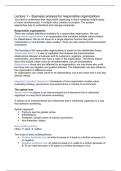Class notes
Full notes Project responsible organizations 2023
- Course
- Institution
PASS YOUR EXAM WITH THESE NOTES! Full notes from the Project Responsible Organizations 2, Business Analysis for Responsible Organizations course lectures. It also includes additional information about VENSIM, the things you need to know before the exam.
[Show more]



